Dementia Orientation Hospital Strategy
Why is a Dementia Friendly Orientation Strategy Important?
Spatial disorientation and declining wayfinding abilities are among the early symptoms of dementia, limiting a person’s ability to perform activities of daily living (ADLs) independently and ultimately, perhaps leading to institutionalization. A prerequisite to maintaining patients’ quality of life in a hospital is their ability to orient themselves within their new environment.
To help with a Dementia Friendly Orientation Strategy, it is often easier to think about your orientation strategy in five areas:
Finds Dementia Friendly Orientation Strategy.

1. Toilet Areas
Ensure all toilet door signs display the same sign that is highly visible and recognisable. Communal toilets located on corridors may also require Toilet flag signs. Ensure that all patients can see a toilet sign from their bed and any communal seating areas.
The use of contrasting coloured toilet seats and rails should be used to reduce the risk of falls.
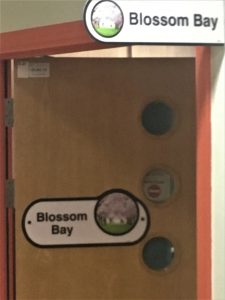
2. Bays and Side Rooms
2. Bays and Side Rooms
Once a patient can successfully found the toilet, they need to be able to return independently to their bed. Many Trusts have taken a multi-cue approach to these areas and use signs that incorporate names, colours, and images to help with identification. Often with a nature theme, such as flowers, each bay or side room is named, and the theme continues throughout. For example, The Daffodil Bay would include a yellow sign with the name and the image of a daffodil. Visuals of the same theme are also used on windows (using Light enabling vinyl or on a feature wall (mural) – depending on space available.
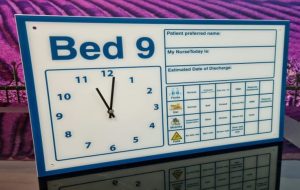
Each patient requires a bed board displaying important information about their care. These should be a bespoke design to suit the patient’s needs, but also staff friendly as they will require regular updating.
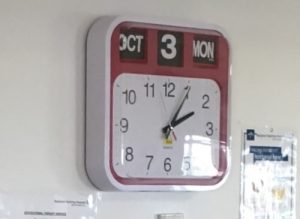
Every patient should be able to see a dementia-friendly clock from their bed to help with orientation (CQC requirement)
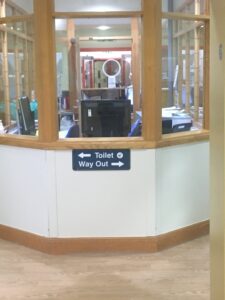
3. Directional Signage and Orientation Aids
3. Directional Signage and Orientation Aids
Keep signage to a minimum as they could potentially cause confusion. Only include directional signs at junctions where there is a choice.
Use artwork and murals in alcoves or safe stopping points to create areas of interest for patients. The Bus Mural and Stop Sign has proven to work very well in many hospital settings. Patients may want to go home, and it is an ideal place to have a chat with them and understand their concerns. It is also a natural seating area where patients can meet and talk to each other.
Do not clutter walls with staff notices and large boards that are rarely updated and add no value to patients. Ensure important information and notices are displayed in the right place and kept to a minimum – we go sign blind!
Hydration stations near nurse stations work well. Patients can visit these at any time and increase their fluid intake. The positioning enables staff to be vigilant without being involved.
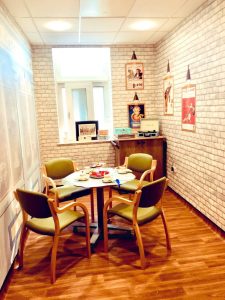
4. Communal Areas
4. Communal Areas
Not all wards are fortunate enough to have day rooms, but where they are available, they can have a really positive affect on wellbeing and ultimately a reduction patient stay.
Murals can transform a plain room into something special and increase engagement and social interaction between patients. Encouraging patients to remain active and visit the day room or café for a drink and snack promotes routine which can aid recovery. For hospitals that support the initiative #endPJparalysis, creating engaging rooms can really help the ward’s culture.
Ensure the day rooms have a range of activities available for group and individual use to meet everyone’s needs. Find Memory Care has provided Trusts with bespoke activity boxes for each ward with items ranging from board games to arts and crafts and even music systems.
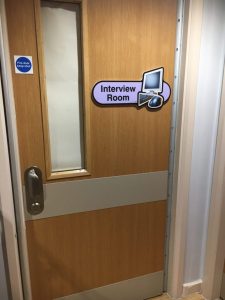
5. Non-patient Areas
5. Non-patient Areas
Staff doors and treatment areas do not need signs to stand out as this will draw attention to locked doors. However, using a low contrast coloured door sign helps staff with orientation and for those patients who are searching for somewhere and find a locked door, the sign helps them to understand it is not an area that holds any interest for them, and this can reduce agitation.
Some doors can be disguised using door cal’s or light enabling vinyl to create interest, but care is needed, and I would recommend speaking to an advisor for guidance.
Staff notices boards should be displayed in non-patient areas where staff have time to read them.
Need Help creating a Dementia Friendly Orientation Strategy?
We hope that you have found this information to developing an orientation strategy useful. If you need further support and would like to arrange a visit contact is using the button below:
